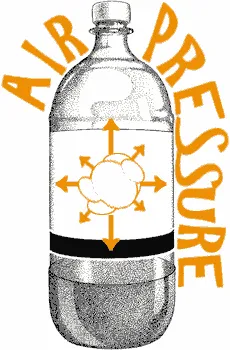 The Teacher's Corner
The Teacher's Corner
Air Pressure Science Experiment
Going from sea level to over 7000 feet makes a big difference in air pressure. As you go higher, the air pressure is less. This can do bad things to the stuff in your suitcase, such as causing shampoo and lotion to squirt all over your clothes. It would be nice to fly all of you up into the mountains to do this experiment, but I can't quite afford that right now. Instead, we will cause a change in air pressure by heating and cooling it.
 To try this, you will need:
To try this, you will need:
- a two liter soft drink bottle or similar plastic bottle with a tight fitting cap
- refrigerator
- hot water
- a bowl of water
To start, remove the cap from the bottle. Place the bottle into the sink and run hot water over the outside of the bottle. After a few seconds of hot water, quickly put the cap on the bottle. Be sure the cap is nice and tight. Then place the bottle into the freezer compartment of your refrigerator. You may have to eat some ice cream in order to make enough room in the freezer for this experiment, but in the name of science I am sure you can do it.
After couple of minutes, open the freezer and look at the bottle. What happened? It looks like someone stepped on it. Turn the bottle upside down in the bowl of water, so that the cap is under the surface. Remove the cap and you will see that the water rushes into the bottle.
You may have to squeeze the bottle a bit to get it back into its original shape. Leave the cap off and put it back into the freezer. Let it stay there for about 10 minutes. Then open the freezer and quickly put the cap on. Bring the bottle out of the freezer and squeeze it a bit to get an idea of the pressure inside. Run some hot water over the bottle and squeeze it again. It feels more firm. Again put the cap under water in the bowl and carefully loosen it. This time instead of water rushing into the bottle, air rushes out.
What does all this tell us? We started by heating the air inside the bottle. This caused the molecules of air inside the bottle to move around faster. Since the top was off of the bottle, the air inside the bottle got bigger and some of it moved outside the bottle. Then you put the cap on and placed it into the freezer. As the air inside the bottle cooled, the molecules moved about less. They banged into the sides of the bottle less and the air pressure inside the bottle decreased. The air pressure outside was now stronger than the pressure in the bottle and the bottle was crushed. When you loosened the cap, the higher pressure outside forced some of the water into the bottle.
When you put the bottle into the freezer without the cap, the molecules again moved less. Since the cap was off, as the molecules moved less, more air moved into the bottle. When you put on the cap and ran hot water over the bottle, the molecules in the air moved about more. The air could not expand because the cap was on, so instead it pushed harder and harder against the sides of the bottle, making it feel more firm. When you loosened the cap under water, the higher pressure inside forced air out of the bottle.
Another way to change air pressure is to move it up or down. If you take the bottle up high into the mountains and put the cap on, when you bring it back down to sea level, the bottle will look crushed. On the other hand, if you put the cap on the bottle when you are at sea level and then take it up into the mountains, the bottle will feel quite rigid. In fact, if the cap is not strong enough, the pressure may force the cap off of the bottle. If the bottle happened to contain sunscreen lotion, the lotion could be forced out of the bottle, onto your clothes. That explains why I need to do some laundry tomorrow. Next time, I will put the bottle inside a plastic bag.
 Check out more Science Experiments
Check out more Science Experiments
All lessons are brought to you by The Teacher's Corner and Robert Krampf's Science Education Company.
Robert Krampf's Science Shows thehappyscientist.com